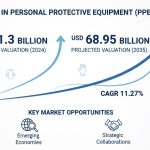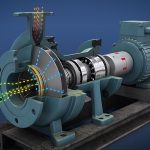Sulfuric Acid Market: Comprehensive Industry Analysis and Future Outlook
According to analysts at Vantage Market Research, The global Sulfuric Acid Market is valued at USD 14.37 Billion in 2024 and is projected to reach a value of USD 21.56 Billion by 2035 at a CAGR (Compound Annual Growth Rate) of 3.80% between 2025 and 2035.
Overview of Sulfuric Acid Market
The sulfuric acid market represents one of the most critical segments within the global chemical industry, serving as the backbone for numerous industrial applications worldwide. Sulfuric acid, chemically known as H2SO4, stands as the most widely produced industrial chemical globally, with annual production exceeding 280 million metric tons. This colorless, odorless, and highly corrosive mineral acid plays an indispensable role in fertilizer manufacturing, metal processing, petroleum refining, and various chemical synthesis processes. The market’s robust growth trajectory is primarily driven by escalating demand from the agricultural sector, particularly phosphate fertilizer production, which accounts for approximately 65% of global sulfuric acid consumption. Additional driving factors include expanding automotive industries requiring battery acid, growing metal mining activities, and increasing industrial chemical production. The market’s resilience stems from sulfuric acid’s versatility and essential nature across multiple industries, making it virtually irreplaceable in many applications.
Get a Sample Copy:- https://www.vantagemarketresearch.com/sulfuric-acid-market-1958/request-sample
Top Key Players
- UBE Industries Ltd. (Japan)
- Boliden Group (Sweden)
- Trident Group (India)
- Tata Chemicals (India)
- Asia Union Electronic Chemical Corporation (Taiwan)
- Hubei Xingfa Chemicals Group Co. Ltd. (China)
- Canada Colors & Chemicals Limited (Canada)
- Maaden – Saudi Arabian Mining Company (Saudi Arabia)
- Nouryon (Netherlands)
- Cornerstone Chemical Company (US)
- Linde Group (Ireland)
- Qingdao Hisea Chem Co. Ltd. (China)
- KMG Chemicals Inc. (US)
- Seastar Chemicals (Canada)
- PVS Chemicals Inc. (US)
- Avantor Performance Materials LLC (US)
- Aurubis (Germany)
- Knato Corporation (US)
- INEOS Group Ltd. (UK)
- BASF SE (Germany)
- The Mosaic Company (US)
- Yunnan Copper Co. Ltd. (China)
- Jiangxi Copper Group Co. Ltd. (China)
- Honeywell International Inc. (US)
- Dupont (US)
- Cytec Industries (US)
- Chevron Philips Chemical (US)
- Akzo Nobel (Netherlands)
- Bayer (Germany)
Market Dynamics
The sulfuric acid market operates within a complex ecosystem influenced by multifaceted supply and demand dynamics that shape its growth trajectory and pricing mechanisms. On the demand side, the agricultural sector remains the primary consumption driver, with phosphate fertilizer production consuming the majority of global sulfuric acid output. This demand correlation with agricultural cycles creates seasonal fluctuations and regional variations based on farming patterns and crop requirements. The industrial segment, encompassing metal processing, petroleum refining, and chemical manufacturing, provides steady baseline demand with growth tied to overall industrial activity levels. Supply dynamics are equally intricate, with production methods varying between sulfur-burning processes, metallurgical smelting recovery, and spent acid regeneration. Raw material availability, particularly elemental sulfur and pyrite, significantly impacts production costs and regional supply capabilities. Transportation logistics play a crucial role due to sulfuric acid’s corrosive nature, necessitating specialized handling equipment and storage facilities. Environmental regulations increasingly influence market dynamics, with stricter emission standards driving technological improvements and potentially affecting production costs. Price volatility remains a constant challenge, influenced by energy costs, raw material prices, environmental compliance expenses, and regional supply-demand imbalances.
Market Segmentation
By Raw Materials
- Base Metal Smelters
- Elemental Sulfur
- Pyrite Ore
- Other Raw Materials
By Forms
- Concentrated
- Tower/Glover Acid
- Chamber/ Fertilizer Acid
- Battery Acid
- 66 Degree Baume Sulfuric Acid
- Dilute Sulfuric Acid
By Manufacturing Process
- Contact Process (80%)
- Lead Chamber Process
- Wet Sulfuric Acid Process
- Metabisulfite Process
- Other Manufacturing Processes
By Distribution Channels
- Online (65.3%)
- Offline (34.7%)
- Specialty Stores
By Applications
- Fertilizers
- Chemical Industries
- Petroleum Refining
- Metal Processing- Steel Picking, Copper Production, Metals Surface Cleaning
- Automotive
- Textile
- Drug Manufacturing
- Pulp & Paper
- Industrial
- Semiconductor Electronics- Battery Electrolyte, Integrated Circuit Components, Fabrication, Photovoltaic Cells
- Wastewater Treatment
- Other Applications
By Purity Type
- Standard
- Ultra-Pure
By Region
- North America
- Europe
- Asia Pacific
- Latin America
- Middle East & Africa
Top Trends
The sulfuric acid industry is experiencing transformative trends that are reshaping traditional market paradigms and creating new opportunities for growth and innovation. Environmental sustainability has emerged as a dominant trend, with manufacturers increasingly adopting cleaner production technologies and implementing circular economy principles through acid recycling and recovery systems. The shift toward sustainable mining practices is driving demand for more efficient acid consumption methods and recovery technologies, particularly in copper and other metal extraction processes. Digital transformation is revolutionizing industry operations, with smart manufacturing systems, IoT-enabled monitoring, and predictive maintenance becoming standard practices for optimizing production efficiency and reducing operational costs. Geographic market expansion is accelerating, with emerging economies in Asia-Pacific and Africa experiencing rapid industrialization, creating substantial new demand centers for sulfuric acid. The renewable energy transition is creating both challenges and opportunities, as traditional fossil fuel applications decline while new applications in battery manufacturing and energy storage systems emerge. Technological innovations in production processes, including advanced catalysts and energy-efficient systems, are improving yield rates and reducing environmental impact. Additionally, the trend toward localized production and regional supply chains is gaining momentum, driven by transportation cost considerations and supply chain resilience requirements following recent global disruptions.
Top Report Findings
- Global sulfuric acid market valuation reached approximately $12.5 billion in 2024, with projections indicating steady growth at a compound annual growth rate of 3.2% through 2030
- Fertilizer production accounts for nearly 65% of total sulfuric acid consumption, making agricultural sector performance a primary market determinant
- Asia-Pacific region dominates global production and consumption, representing over 45% of worldwide sulfuric acid demand due to extensive industrial activities
- Environmental regulations are driving increased adoption of acid recovery and recycling technologies, with recovery rates improving by 15% annually
- Metal processing industry shows strongest growth potential, with copper mining operations expanding sulfuric acid consumption by 8% year-over-year
- Transportation costs represent 20-30% of total sulfuric acid delivered price, emphasizing importance of regional production capabilities
- Battery manufacturing sector emerging as significant growth driver, with electric vehicle expansion creating new demand streams
- Technological innovations in production efficiency have reduced energy consumption by 12% over the past five years across major production facilities
Challenges
The sulfuric acid market faces significant operational and strategic challenges that impact industry growth and profitability across various dimensions. Environmental compliance represents the most pressing challenge, as increasingly stringent regulations regarding sulfur dioxide emissions, wastewater discharge, and workplace safety require substantial capital investments in pollution control equipment and monitoring systems. These regulatory requirements often vary significantly between regions, creating complex compliance landscapes for multinational operators. Transportation and logistics challenges are particularly acute due to sulfuric acid’s highly corrosive nature, requiring specialized equipment, trained personnel, and comprehensive safety protocols that substantially increase operational costs. Market volatility poses ongoing challenges, with price fluctuations driven by raw material costs, energy prices, and supply-demand imbalances creating uncertainty for both producers and consumers. The industry also grapples with aging infrastructure at many production facilities, necessitating significant maintenance and modernization investments to maintain competitive efficiency levels. Raw material supply security represents another critical challenge, particularly for regions dependent on imported sulfur or those affected by geopolitical tensions that can disrupt supply chains. Additionally, the industry faces growing pressure to develop more sustainable production methods while maintaining cost competitiveness in increasingly price-sensitive markets.
Opportunities
The sulfuric acid market presents numerous promising opportunities for growth and expansion driven by emerging applications and evolving industrial requirements. The rapidly expanding battery manufacturing sector, particularly for electric vehicles and energy storage systems, offers substantial growth potential as sulfuric acid remains essential for lead-acid battery production and emerging battery technologies. Developing economies present significant market expansion opportunities, with infrastructure development, industrialization, and agricultural modernization creating sustained demand growth in regions such as Southeast Asia, Africa, and Latin America. Technological innovation opportunities abound in production efficiency improvements, environmental impact reduction, and acid recovery systems that can simultaneously reduce costs and enhance sustainability credentials. The growing emphasis on circular economy principles creates opportunities for companies developing advanced acid recycling and regeneration technologies. Mining sector expansion, particularly in copper, zinc, and rare earth metal extraction, provides robust demand growth prospects as global infrastructure and renewable energy projects require increased metal production. Additionally, emerging applications in pharmaceutical manufacturing, specialty chemical production, and advanced materials processing offer niche market opportunities with potentially higher profit margins. Strategic partnerships and vertical integration opportunities exist for companies seeking to secure raw material supplies or expand into downstream applications, providing greater market control and value capture potential.
Key Questions Answered in Sulfuric Acid Market Report
- What are the primary factors driving global sulfuric acid market growth across different geographic regions?
- How do environmental regulations impact sulfuric acid production costs and market competitiveness?
- Which end-user industries demonstrate the strongest growth potential for sulfuric acid consumption?
- What role does transportation infrastructure play in regional sulfuric acid market development?
- How are technological innovations affecting sulfuric acid production efficiency and environmental impact?
- What are the key challenges facing sulfuric acid producers in maintaining market competitiveness?
- Which geographic regions offer the most promising opportunities for sulfuric acid market expansion?
- How do raw material price fluctuations affect sulfuric acid market dynamics and pricing strategies?
- What impact do sustainability initiatives have on sulfuric acid production and consumption patterns?
- How is the growing electric vehicle market influencing sulfuric acid demand projections?
- What are the most effective strategies for managing sulfuric acid supply chain risks and disruptions?
- How do seasonal agricultural patterns affect sulfuric acid demand cycles and inventory management?
Regional Analysis – North America
North America represents a mature and technologically advanced sulfuric acid market characterized by sophisticated production capabilities, stringent environmental standards, and diverse end-user applications that distinguish it from other global regions. The United States dominates regional production and consumption, with approximately 15 major production facilities strategically located near key industrial centers and transportation hubs. Canada contributes significantly through its extensive mining operations, particularly in copper and other metal extraction processes that require substantial sulfuric acid volumes. The region’s market dynamics are heavily influenced by agricultural cycles, with spring and summer months showing increased demand for phosphate fertilizer production. Environmental regulations in North America are among the world’s most stringent, driving continuous technological improvements and significant investments in emission control systems. The region benefits from well-developed transportation infrastructure, including specialized rail networks and pipeline systems that efficiently distribute sulfuric acid to major consumption centers. Recent trends show growing demand from battery manufacturing facilities, particularly as electric vehicle production expands across the region. The North American market also demonstrates strong emphasis on acid recovery and recycling technologies, with several facilities achieving recovery rates exceeding 95%. Regional suppliers increasingly focus on providing technical services and customized solutions rather than competing solely on price, reflecting the market’s maturity and sophistication. Mexico’s growing industrial sector adds another dimension to regional dynamics, with expanding manufacturing capabilities creating additional demand growth opportunities.
Conclusion
The sulfuric acid market continues to demonstrate remarkable resilience and growth potential despite facing various challenges related to environmental compliance, transportation logistics, and market volatility. The industry’s fundamental importance across multiple sectors, from agriculture to manufacturing, ensures sustained demand while emerging applications in battery technology and sustainable mining practices provide exciting growth opportunities. Success in this market increasingly depends on technological innovation, environmental stewardship, and strategic positioning to capitalize on regional growth opportunities while managing operational complexities effectively.
![[Market Research Reports] – Research Google News Blog | VMR.Biz](https://www.vmr.biz/wp-content/uploads/2022/12/logo-removebg-preview.png)











